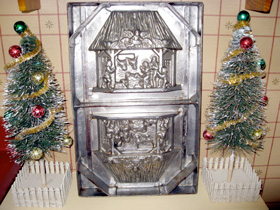 The gift of a box of Christmas sweets is a time-honored tradition, popular with both young and old. Candy was often given to youngsters at Christmastime by Sunday school teachers, public schools, churches and civic groups as part of local festivities.
The gift of a box of Christmas sweets is a time-honored tradition, popular with both young and old. Candy was often given to youngsters at Christmastime by Sunday school teachers, public schools, churches and civic groups as part of local festivities.
Commercially-made candy boxes were offered in Sunday school supply catalogs starting in the early 1880s. Fancy lithographed pasteboard boxes, in shapes such as an automobile or kitchen range, eventually gave way to the rectangular cardboard box printed in 4 colors. In 1902, the National Biscuit Company introduced a specially-designed red and green box with a circus theme. As a tie-in to the Christmas season, a short cheesecloth tape was added so that it could be hung on the branches of the Christmas tree. The relatively unchanged shape we know of as the animal crackers box is the longest-running design in continuous production.
Christmas candy boxes often had a string handle or flap and were shipped flat for later assembly. Once folded, they were typically filled with popcorn, nuts, cookies or biscuits, hard candy or a small toy. Both religious themes and secular themes were popular. Early motifs included the chimney brick, holly or poinsettia. As an alternative to hanging on the tree, “brick” candy boxes could be arranged to simulate a chimney or fireplace for stage decoration before they were distributed to the children.
Throughout the 1940s and 1950s, the Sears, Roebuck & Co. catalog offered a variety of designs in several sizes to contain from two ounces to one whole pound of candy! The most popular size, with approximate dimensions of 4-1/4 x 3 x 1-3/4, was available for purchase in bulk and could be filled with up to 8 ounces of hard candy. In many cases, a title and/or number was assigned to each design by the manufacturer and was often printed on one flap of the box. Based on the numbering system,more than one hundred designs were issued in various sizes over the years! However, by the early 1970s, Sears offered only one candy box, featuring a stylized Santa coming head-first down the chimney.
Christmas candy boxes have long since disappeared from the pages of the Sears Wish Book and Sunday school supply house catalogs. But their colorful graphics and the nostalgia they evoke live on in our hearts and in our collections!




